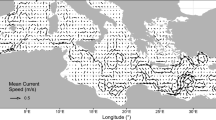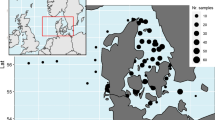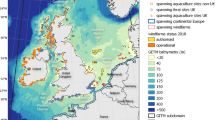Abstract
Forecasting the range expansion of nonindigenous organisms enables effective quarantine and the development of pre-arrival countermeasures, as well as raises public and scientific concerns among the general public. Here, we present an approach to forecasting the range expansion of the nonindigenous green crab Carcinus in Japanese waters, with consideration of the human-mediated shipping and natural dispersal. Two types of shipping, namely, primary transport to Japan via long-distance ocean-going shipping and secondary transport within Japan via short-distance coastal shipping, were considered. The presence and absence of the crab in 50-km shoreline segments were obtained at 5 year intervals from 1985 to 2005, based on observation records by professional and amateur naturalists. Two types of dispersal kernel, namely, conventional logistic regression and a multiplicative immigration model considering multiple pathways explicitly, were compared. The multiplicative immigration model gave significantly better results. Natural dispersal was the most significant factor, in spite of its low expansion rate: secondary transport by coastal shipping was the second. Transport by international ocean-going shipping was not statistically significant, suggesting quite a small immigration probability of the crab by long voyages. Stochastic simulations forecasted that the crab will invade most of the coasts of western Japan along the Pacific Ocean and Seto Inland Sea by 2055, and will become widespread all over the country by 2205. Quarantine scenarios to eliminate transport by vessels revealed that preventing crab transport by domestic coastal vessels may delay the arrival of crabs in Hokkaido and the northern Japan area by 700 years at maximum.








Similar content being viewed by others
References
Akaike H (1974) A new look at the statistical model identification. IEEE Trans Automat Control 19:716–723
Almaça C (1989) Biogeographical notes on the Mediterranean Brachyura. Crustaceana 56:14–17
Bagely MJ, Geller JB (2001) Micorsatellite DNA analysis of native and invading populations of European green crabs. In: Pederson J (ed) Marine bioinvasions. Proceedings of the first national conference. Massachusetts Institute of Technology, MIT Sea Grant College Program, MITSG 00-2, Cambridge, Massachusetts, pp 241–243
Broadfoot JD, Rosatte RC, O’Leary DT (2001) Raccoon and skunk population models for urban disease control planning in Ontario, Canada. Ecol Appl 11:295–303
Carlton JT, Cohen AN (2003) Episodic global dispersal in shallow water marine organisms: the case history of the European shore crabs Carcinus maenas and C. aestuarii. J Biogeogr 30:1809–1820
Chen R, Watanabe S, Yokota M (2003) Dispersion of the exotic crab, Carcinus aestuarii, in Japan. Cancer 12:11–13 (in Japanese)
Chen RB, Watanabe S, Yokota M (2004) Feeding habits of an exotic species, the Mediterranean green crab Carcinus aestuarii, in Tokyo Bay. Fish Sci 70:430–435
Clark PF, Neale M, Rainbow PS (2001) A morphometric analysis of regional variation in Carcinus Leach, 1814 (Brachyura: Portunidae: Carcininae) with particular reference to the status of the two species C. maenas (Linnaeus, 1758) and C. aestuarii Nardo, 1847. J Crustac Biol 21:288–303
Cohen AN, Carlton JT, Fountain MC (1995) Introduction, dispersal and potential impacts of the green crab Carcinus maenas in San Francisco Bay, California. Mar Biol 122:225–237
Costello C, Springborn M, McAusland C, Solow A (2007) Unintended biological invasions: does risk vary by trading partner? J Environ Econ Manag 54:262–276
Coutts AJ, Taylor MD (2004) A preliminary investigation of biosecurity risks associated with biofouling on merchant vessels in New Zealand. New Zealand J Mar Fresh Res 38:1–15
Darling JA, Bagley MJ, Roman J, Tepolt CK, Geller JB (2008) Genetic patterns across multiple introductions of the globally invasive crab genus Carcinus. Mol Ecol 17:4992–5007
de Rivera CE, Ruiz GM, Hines AH, Jivoff P (2005) Biotic resistance to invasion: native predator limits abundance and distribution of an introduced crab. Ecology 86:3364–3376
Doi K, Watanabe S, Furota T (2009) Nonindigenous crabs populated within large bays near the large cities in Japan. In: The Plankton Society of Japan, Japanese Society of Benthology (ed) Marine aliens introduced by human activities and their impacts on ecosystems and industries. Tokai University Press, Tokyo, pp 75–90 (in Japanese)
Drake JM, Lodge DM (2004) Global hotspots of biological invasions: evaluating options for ballast-water management. Proc R Soc Lond B 271:575–580
Efron B, Tibshirani R (1993) An introduction to the bootstrap. Chapman & Hall, New York
Facon B, David P (2006) Metapopulation dynamics and biological invasions: a spatially explicit model applied to a freshwater snail. Am Nat 168:769–783
Fukasawa K, Koike F, Tanaka N, Otsu K (2009) Predicting future invasion of an invasive alien tree in a Japanese oceanic island by process-based statistical models using recent distribution maps. Ecol Res 24:965–975
Furota T, Kinoshita K (2004) Life histories of introduced crabs, the majid Pyromaia tuberculata and the portunid Carcinus aestuarii, in Tokyo bay and their adaptability to seasonal hypoxia caused by organic pollution. Jpn J Benthol 59:96–104 (in Japanese with English abstract)
Furota T, Watanabe S, Akiyama S, Kinoshita K (1999) Life history of the Mediterranean green crab, Carcinus aestuarii Nardo, in Tokyo Bay, Japan. Crustac Res 28:5–15
Geller JB, Walton ED, Grosholz ED, Ruiz GM (1997) Cryptic invasions of the crab Carcinus detected by molecular phylogeography. Mol Ecol 6:901–906
Gosling EM (1992) Systematics and geographic distribution of Mytilus. In: Gosling EM (ed) The mussel Mytilus: ecology, physiology, genetics and culture. Elsevier, Amsterdam, pp 1–20
Grosholz ED (1996) Contrasting rates of spread for introduced species in terrestrial and marine systems. Ecology 77:1680–1686
Grosholz ED, Ruiz GM (1995) Spread and potential impact of the recently introduced European green crab, Carcinus maenas, in central California. Mar Biol 122:239–247
Grosholz ED, Ruiz GM (1996) Predicting the impact of introduced marine species: lessons from the multiple invasions of the European green crab Carcinus maenas. Biol Conserv 78:59–66
Hanski I (1998) Metapopulation dynamics. Nature 396:41–49
Havel JE, Shurin JB, Jones JR (2002) Estimating dispersal from patterns of spread: spatial and local control of lake invasions. Ecology 83:3306–3318
Hidalgo FJ, Baron PJ, Orensanz JM (2005) A prediction come true: the green crab invades the Patagonian coast. Biol Invasions 7:547–552
Iwasaki K (2006) Human-mediated introduction of marine organisms in Japan: a review. In: Koike F, Clout MN, Kawamichi M, De Poorter M, Iwatsuki K (eds) Assessment and control of biological invasion risks. Shoukadoh Book Sellers, IUCN, Kyoto, Gland, pp 104–112
Iwasaki K, Kimura T, Kinoshita K, Yamaguchi T, Nishikawa T, Nishi E, Yamanishi R, Hayashi I, Okoshi K, Kosuge T, Suzuki T, Henmi Y, Furota T, Mukai H (2004a) Human-mediated introduction and dispersal of marine organisms in Japan: results of a questionnaire survey by the Committee for the Preservation of the Natural Environment, the Japanese Association of Benthology. Jpn J Bentho l59:22–44 (in Japanese with English abstract)
Iwasaki K, Kinoshita K, the Committee for the Preservation of the Natural Environment, the Japanese Association of Benthology (2004b) Range expansion of non-indigenous marine benthos introduced into Japan through human activities. Bull Plankton Soc Jpn 51:132–144 (in Japanese with English abstract)
Japan Oceanographic data Center (2008) Statistics on sea water temperature (web page, http://www.jodc.go.jp/index_j.htm, cited 24 December 2008)
Jerde CL, Lewis MA (2007) Waiting for invasions: a framework for the arrival of nonindigenous species. Am Nat 170:1–9
Koike F (2006) Prediction of range expansion and optimum strategy for spatial control of feral raccoon using a metapopulation model. In: Koike F, Clout MN, Kawamichi M, De Poorter M, Iwatsuki K (eds) Assessment and control of biological invasion risks. Shoukadoh Book Sellers, IUCN, Kyoto, Gland, pp 148–156
Koike F (2009) Minna de GIS, http://www13.ocn.ne.jp/~minnagis/
Komuro T, Koike F (2005) Colonization by woody plants in fragmented habitats of a suburban landscape. Ecol Appl 15:662–673
Lafferty KD, Kuris AM (1996) Biological control of marine pests. Ecology 77:1989–2000
Le Roux PJ, Branch GM, Joska MAP (1990) On the distribution, diet and possible impact of the invasive European shore crab Carcinus maenas (L.) along the South African coast. S Afr J Mar Sci 9:85–92
Leung B, Mandrak NE (2007) The risk of establishment of aquatic invasive species: joining invasibility and propagule pressure. Proc R Soc B 274:2603–2609
Lindley JA (1987) Continuous plankton records: the geographical distribution and seasonal cycles of decapod crustacean larvae and pelagic post-larvae in the north-eastern Atlantic Ocean and the North Sea, 1981–3. J Mar Biol Assoc UK 67:145–167
Lubina JA, Levin SA (1988) The spread of a reinvaded species: RAnge expansion in the California sea otter. Am Nat 131:526–543
Lurz PWW, Rushton SP, Wauters LA, Bertolino S, Currado I, Mazzoglio P, Shirley MDF (2001) Predicting grey squirrel expansion in North Italy: a spatially explicit modelling approach. Landsc Ecol 16:407–420
Mistri M (2004) Prey preference of Carcinus aestuarii: possible implications with the control of an invasive mytilid and Manila clam culture in a northern Adriatic lagoon. Aquaculture 230:261–272
Morgan DE, Goodsell J, Mathiessen GC, Garey J, Jacobson P (1980) Release of hatchery-reared bay scallops (Argopecten irradians) onto a shallow coastal bottom in Waterford, Connecticut. Proc World Maricult Soc 11:247–261
Muraoka K (1996) Notes on the appearance of green crab, Carcinus mediterraneus, in Tokyo Bay. Cancer 5:29–30 (in Japanese)
Nabeshima Y, Kusakabe T, Ohmi H, Yamashita T (1997) First record of the Mediterranean green crab in Osaka bay. Nat Study 43:75–78 (in Japanese)
Otani M (2004) Introduced marine organisms in Japanese waters, and the processes involved in their entry. Jpn J Benthol 59:45–57 (in Japanese with English abstract)
Otani M (2006) Important vectors for marine organisms unintentionally introduced to Japanese waters. In: Koike F, Clout MN, Kawamichi M, De Poorter M, Iwatsuki K (eds) Assessment and control of biological invasion risks. Shoukadoh Book Sellers, IUCN, Kyoto, Gland, pp 92–103
Queiroga H (1996) Distribution and drift of the crab Carcinus maenas (L.) (Decapoda, Portunidae) larvae over the continental shelf off northern Portugal in April 1991. J Plankton Res 18:1981–2000
Roff JC, Fanning LP, Stasko AB (1986) Distribution and association of larval crabs (Decapoda: Brachyura) on the Scotian Shelf. Can J Fish Aquat Sci 43:587–599
Rolim MH (2008) The international law on ballast water: preventing biopollution. Publications on ocean development, vol 63. Martinus Nijhoff Publishers, Rotterdam
Roman J, Palumbi SR (2004) A global invader at home: population structure of the green crab, Carcinus maenas, in Europe. Mol Ecol 13:2891–2898
Ruiz GM, Carlton JT (2003) Invasion vectors: a conceptual framework for management. In: Ruiz GM, Carlton JT (eds) Invasive species: vectors and management strategies. Island Press, Washington, pp 459–504
Ruiz GM, Carlton JT, Grosholz ED, Hines AH (1997) Global invasions of marine and estuarine habitats by non-indigenous species: mechanisms, extent, and consequences. Am Zool 37:621–632
Sakai T (1986) Rare species and their genus of crabs in Japan. Res Crustac 15:1–4 (in Japanese)
Seeley RH (1986) Intense natural selection caused a rapid morphological transition in a living marine snail. Proc Natl Acad Sci USA 83:6897–6901
Shigesada N, Kawasaki K (1997) Biological invasions: theory and practice. Oxford University Press, Oxford
Skellam JG (1951) Random dispersal in theoretical populations. Biometrika 38:196–218
Sokal RB, Rohlf FJ (1995) Biometry, 3rd edn. Freeman, New York
Takeda M, Horikoshi N (1993) Notes on a shore swimming crab from the Mediterranean Sea, Carcinus mediterraneus Czerniavsky, established in Tokyo Bay. Aquabiology 85:121–124 (in Japanese)
Tamura S (1999) Notes on Mediterranean green crab, Carcinus mediterraneus Czerniavsky, collected from the Tagoe River, Zushi, Kanagawa Prefecture. Kanagawa Shizenshi Siryo 20:81–84 (in Japanese)
Thresher R, Proctor C, Ruiz G, Gurney R, MacKinnon C, Walton W, Rodriguez L, Bax N (2003) Invasion dynamics of the European shore crab, Carcinus maenas, in Australia. Mar Biol 142:867–876
Transport Research and Statistics Office, Information Security, Research and Statistics Division, Ministry of Land, Infrastructure and Transport (2008) Annual Statistical Report 2005 on Imports and Coastwise Vessel Transport (web page, http://toukei.mlit.go.jp/saisintoukei.html#ryuudou, cited 15 January 2008)
Trussell GC (2000) Phenotypic clines, plasticity, and morphological trade-offs in an intertidal snail. Evolution 54:151–166
Vander Zanden MJ, Olden JD (2008) A management framework for preventing the secondary spread of aquatic invasive species. Can J Fish Aquat Sci 65:1512–1522
Vermeij GJ (1982) Phenotypic evolution in a poorly dispersing snail after arrival of a predator. Nature 299:349–350
Wasson K, Zabinc CJ, Bedingerb L, Diazb MC, Pearse JS (2001) Biological invasions of estuaries without international shipping: the importance of intraregional transport. Biol Conserv 102:143–153
Watanabe S (1995) The massive appearance of the Mediterranean green crab, Carcinus mediterraneus, in Tokyo Bay. Cancer 4:9–10 (in Japanese)
Watanabe S (1997) Notes on the invasion and growth of the Mediterranean green crab population. Cancer 6:37–40 (in Japanese)
Watanabe T (2000) Record of massive appearance of Carcinus mediterraneus Czerniavsky (Crustacea, Brachyura) in the Channel of Hamadera, Osaka. Nanki Seibutsu 42:104 (in Japanese)
Yamada SB, Hauck L (2001) Field identification of the European green crab species: Carcinus maenas and Carcinus aestuarii. J Shellfish Res 20:905–912
Yamada SB, Dumbauld BR, Kalin A, Hunt CE, Figlar-Barnes R, Randall A (2005) Growth and persistence of a recent invader Carcinus maenas in estuaries of the northeastern Pacific. Biol Invasions 7:309–321
Acknowledgments
We are grateful to Michio Otani (Marine Ecological Institute, Inc.) for advice on trade and shipping data. This study was supported in part by the JSPS Global COE Program “Global eco-risk management from Asian viewpoints” and Grants-in-Aid for Scientific Research, from the Japan Society for the Promotion of Science (No. 18510208 for K. I.).
Author information
Authors and Affiliations
Corresponding author
Rights and permissions
About this article
Cite this article
Koike, F., Iwasaki, K. A simple range expansion model of multiple pathways: the case of nonindigenous green crab Carcinus aestuarii in Japanese waters. Biol Invasions 13, 459–470 (2011). https://doi.org/10.1007/s10530-010-9841-5
Received:
Accepted:
Published:
Issue Date:
DOI: https://doi.org/10.1007/s10530-010-9841-5




